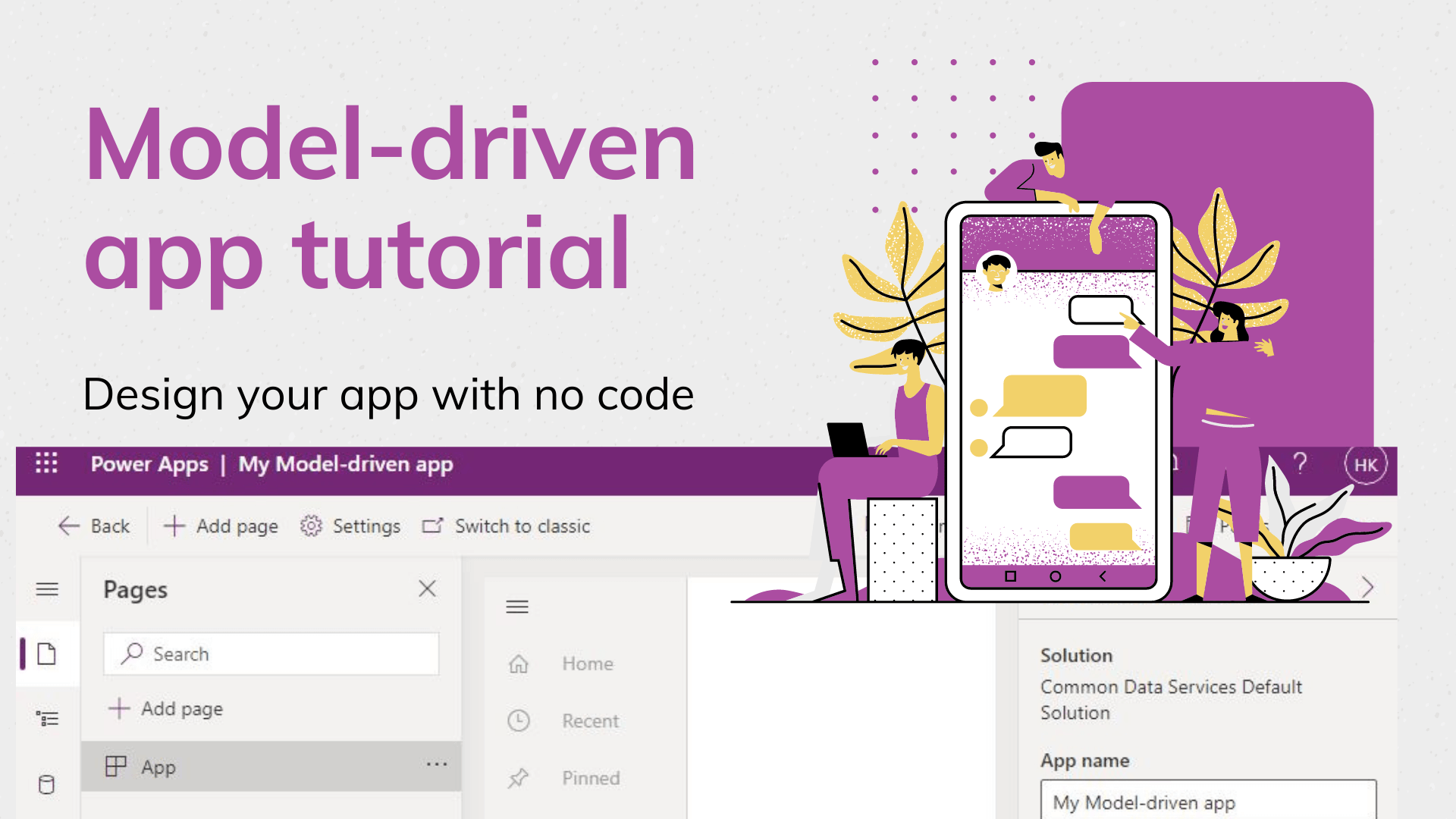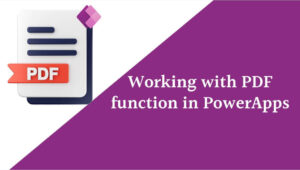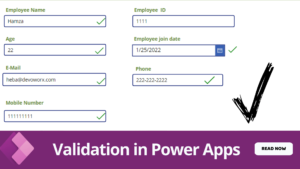Model-driven apps are generally a focused approach to app development without writing any code, Model-Driven app in PowerApps focuses on adding components such as forms, views, charts, and dashboards to tables. So in this article, we will give a model-driven app developer guide.
What is Model Driven app in PowerApps?
- Model-driven apps are one of the three apps that you can create in Power Apps.
- Model-driven apps are generally a component-focused no-code or low-code approach to app development.
- Model-driven apps are built on top of microsoft dataverse.
To create Model-Driven apps in Power Apps, you must have environemnt with database “the dataVerse”.
If you are new to the Dataverse applications, you can check this article.
- It is recommend to create your model-driven app from a solution that can contain Dataverse tables, forms, views, apps, flows, and other components.
- In Model-driven apps, You start with the data model , you can create your tables and your relationships between those tables and then starting building your app by simply connecting to your tables in microsoft DataVase and leveraging forms and views that you create inside the data model.
Without a data model housed within Microsoft Dataverse, you can’t create any model-driven apps.
- Once the data model and relationships have been created, you will start to add components to the Model driven app with no-code designers.
- With Model-driven apps you can build end-to-end responsive business applications without any additional codes.
Model-driven apps are responsive by design.
- The UI controls in Model driven app are Limited and predominantly customization.
- Migration between environments are simple and the migration done using solutions.
How to create a model-driven application in power apps?
In this section, I will show you how to create a Model-driven app and what are the steps you must follow to create the model-driven apps in Power Apps?
Steps to building model-driven app
- Modeling business data, you start with the data model in mind,you can create your tables and create the tables relationships between those tables to ensure that the data is built correctly in order to solve the business problem, all are done in DataVerse .
- Defining your business processes
- Composing the model-driven app,by building your app using the modern app designer, or the classic app designer.
- Configuring security roles, these actions such as Create, Read, Write, Delete, Append, Append To, Assign and Share.
- Sharing the Model driven app.
How to open model driven app in PowerApps?
- From the Make site
- In the apps sections select your Model driven app and click … and then choose play or Edit the App.

This is how to open the model-driven app in PowerApps in a display mode or Edit mode
Create a model-driven application in Power Apps
You can create Your model-driven app either in a solution or from the start from option.
It is recomended to create Model driven app in a solution as a package to contain the DataVerse table, forms, views and all the required components in your Model-driven app.
Create A model-driven app out of a solution.
- Open the Make site
- You can Build your app from blank or you can start using one of the Model-driven app existing templates.
- To create a model-driven app in power apps from blank, click start from Blank app,

- And then choose the Create button under the Model driven app.

- You will asked to Select a creating experience.
After you Model your data to create the building blocks of your app, let Power Apps design the look.
using Modern app designer or the classic app designer
Modern app designer are in preview till this moment

- Type a name for your Model-driven app and then click Create, It will take some moments to prepare your app.

- Now your Model driven app are available on the app designer and now you can start add components to design your app.

- you can create your model-driven app by simply connecting to your tables in microsoft DataVerse and leveraging the forms and views that you create insidethe data model itself. The beauty of model driven apps is you’re focusing on the data model as the data model changes for example when new columns are added, the form , the views are updated. all of those will automatically respect the data model updates.
Create A model-driven app inside a solution.
- Open the Make site
- From the left navigation pane select Solution.
- New Solution and complete the required information

Display name : name for your solution , You can change this later
Name: The unique name of the solution that generated automatically from the Display name, you can change it before saving the solution, but after saving the solution, you can’t change it.
Publisher: It is recommend to create a publisher for your organization to use, you can also select the default publisher.
Version: It is important if you export your solution. The version number will be included in the file name when you export the solution.
- After creating the solution , You can add exisisting components from Add existing menu such as tables, Apps canvas or model driven app, Dashboards, chat bots and so on.
- Or you can create the new component from New menu and add your new model driven apps, canvas reports tables and so on.

this is how to create a model-driven application in power apps inside or outside a solution.
How to design Model Driven app in PowerApps?
After we create a model-driven application in power apps, Now you will design Model driven app in PowerApps, Model-driven apps are truly no-code, all you have to do is create your app, connect to your data model “your tables” bring in your forms, views, and publish your app.
To design a Model-driven app you can use:
- The modern app designer that enabling you to see exactly how the app will appear to users when published.
- The classic app designer
Select Switch to classic to use the classic designer to complete the app design tasks that aren’t currently available in the Modern app designer.
Till the article created date there are limtation using model driven app, you cant create these components ,URLs, Business process flows, Charts, You can’t change the app’s icon or specify the app’s URL.
In the modern designer app, you can add pages of the following types
- Table based view and form: Display records of a data table in a full-page list view. Creating a data view page also adds an associated form page for viewing and editing data on a selected record.
- Dashboards: Display charts and tables from multiple entities to visualize data on a single page.
- Custom: Design and build the page you want by dragging interactive components into the canvas.

We will learn how to design the Model driven app in detail in the next article.
How to change model driven app logo?
Currently, you can’t change it from the modern designer you have to switch to the classic designer.
- From the properties in the right navigation, uncheck the Use Default Image check box.
- and you can choose your prefered icon from the combobox that will appear.

Conclusion
You can create a model-driven application in power apps inside or outside a solution.
you can use the modern designer or the classic one to design your model driven app in PowerApps, and there are some limitations while using the modern designer and you can switch to the classic one to perform them such as changing the model-driven app logo, URL, and to create Business process flows, Charts,
See Also
- What are Microsoft Power Apps?
- PowerApps Print Function, Forms, And Scrollable Galleries
- PowerApps Validation Examples On/before Submitting
- Share PowerApps With External Users / Guest Users
- Sign Up and use Power Apps
- PowerApps Canvas App Vs Model-driven App Vs Portal App.
- What Is Microsoft Dataverse?
- How to share Power Apps to Office 365 group
- Connectors in a Power Apps.
- Share Power Apps to external users (guest users)
- How To Create A PowerApps Custom Connector?
- How To Create Power Apps DataFlows?
- Learn Power Apps – youtube channel.



